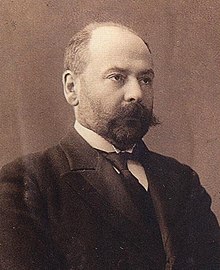Boris Petrovich vineyard
Boris Petrovich vineyard ( Russian Борис Петрович Вейнберг * July 20 . Jul / 1. August 1871 greg. In Peterhof ; † 18th April 1942 in Leningrad ) was a Russian physicist , geophysicist , glaciologist and university teachers .
Life
Weinberg's father was the poet , translator and literary scholar Pyotr Isayevich Weinberg . The satirist and dramaturge Pavel Issajewitsch Weinberg was his uncle. Lyubow Grigoryevna Weinberg b. Rubinstein, the wife of his uncle Jakow Issajewitsch Weinberg, was Anton Rubinstein's sister . The composer Jakow Wladimirowitsch Weinberg and the writer Pawel Pawlowitsch Weinberg were his cousins.
Weinberg has been interested in physics since childhood . He graduated from the St. Petersburg Gurewitsch -Gymnasium and then studied physics at the University of St. Petersburg, especially with Dmitri Mendeleev , graduating in 1893. He then worked at the St. Petersburg Mining Institute and the Imperial New Russian University in Odessa . He lectured at the St. Petersburg Higher Bestuzhev Courses for Women . In 1906 he received the Lomonosov Prize for his work on the internal friction of ice .
In 1909 Weinberg was appointed to the physics chair at the Tomsk Technological Institute , which he held until 1924. At the same time he gave lectures at Tomsk University and the Siberian Higher Courses for Women . One of his most famous students was Vladimir Kuznetsov .
Together with colleagues, Weinberg proposed to the responsible Ministry of Education to establish a chair for aviation at the Tomsk Technological Institute. At the same time, the group applied for land for a laboratory and an airfield from the city of Duma . The ministry initially refused due to a lack of funds. After further efforts, the second aerodynamic institute in Russia was founded in Tomsk in 1910 (after the first institute founded by Nikolai Zhukovsky near Moscow in 1904 ). In the autumn of 1911 the first airplane built in Siberia , a two-seater, flew over the Tomsk Gardens. Nikolai Kamow received his training here, and the twelve-year-old Michail Mil won a competition here in 1921 with his model airplane.
In addition, Weinberg developed a project for the construction of vacuum tunnels for railroad trains . In 1913 the world's first experimental model was presented. In 1914, in a lecture in St. Petersburg, he proposed a magnetic levitation train in a vacuum tunnel. One of the particularly impressed listeners was Jakow Perelman . 100 years later, this concept found new interest in the form of the hyperloop .
Weinberg was a member of the Tomsk City Duma. In 1918 after the October Revolution he became a member of the Siberian Duma , in which he belonged to the faction of regionalists and non-party members.
In 1920 Weinberg took part in the Obbusen expedition. In 1923 he founded one of the first research institutes in Siberia, the Siberia Institute (today the Siberian Physics and Technology Institute), of which he was the first director. In 1924 he became director and then a full member of the main geophysical observatory in Leningrad. In 1940 he became head of department at the Institute for Geomagnetism in Pavlovsk, which was founded in 1939 . During the Leningrad blockade, he worked as an ice expert in setting up the ice roads across Lake Ladoga .
Weinberg died of starvation in Leningrad and was buried in a mass grave. He was the father of the energy technician Vsevolod Borisovich Weinberg . The 900 m high Mount Veynberg on the Arrowsmith Peninsula in West Antarctica was named after Weinberg .
Individual evidence
- ↑ Article Weinberg Boris Petrovich in the Great Soviet Encyclopedia (BSE) , 3rd edition 1969–1978 (Russian)
- ↑ a b Г. В. Островская: Дорога жизни профессора Б. П. Вейнберга и его ледяная гора. К 140-летию Б. П. Вейнберга и 70-летию Дороги Жизни . In: Известия Томского политехнического университета . tape 319 , no. 2 , 2011, p. 149–156 ( earchive.tpu.ru ).
- ↑ Гимназии (accessed January 20, 2017).
- ↑ Б. П. Вейнберг: О внутреннем трении льда . St. Petersburg 1906.
- ↑ Магнитоплан профессора Вейнберга (accessed January 20, 2017).
- ↑ Ekaterina Turysheva: Russian ideas inspire California's Hyperloop plan (accessed January 19, 2017).
- ^ Traveling at 500 miles per hour in the future electric railway . In: The Electrical Experimenter . tape 4 , no. 11 , 1916, pp. 794 ( library.si.edu ).
- ↑ Сибирский физико-технический институт им. акад. В.Д. Кузнецова (accessed January 20, 2017).
- ↑ Veynberg, Mount (accessed January 20, 2017).
| personal data | |
|---|---|
| SURNAME | Weinberg, Boris Petrovich |
| ALTERNATIVE NAMES | Вейнберг, Борис Петрович (Russian); Veynberg, Boris Petrovich |
| BRIEF DESCRIPTION | Russian physicist, glaciologist and university professor |
| DATE OF BIRTH | August 1, 1871 |
| PLACE OF BIRTH | Peterhof |
| DATE OF DEATH | April 18, 1942 |
| Place of death | Leningrad |
